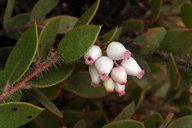Taxon Report
Arctostaphylos myrtifolia ParryIone manzanita |
 © 2006 Steve Matson |
Taxon Summary
Arctostaphylos myrtifolia, commonly known as Ione manzanita, is a perennial evergreen shrub in the Ericaceae that is found only in California. It occurs within Chaparral, and Cismontane woodland, growing at elevations from 60 to 580 meters. Arctostaphylos myrtifolia is ranked 1B.2, Plants Rare, Threatened or Endangered in California and Elsewhere; Moderately threatened in California.Classification
|
Scientific Name: |
Arctostaphylos myrtifolia Parry |
|
Common Name: |
Ione manzanita |
| Family: | Ericaceae |
| Element Code: | PDERI04240 |
| USDA Plants Symbol: | ARMY |
|
Synonyms/Other Names: |
|
Ecology and Life History
| Lifeform: | perennial evergreen shrub |
| Blooming Period: Nov-Mar | Nov-Mar |
| Elevation: | 60-580 (195-1905) |
| General Habitats: | Chaparral, Cismontane woodland |
| Microhabitat: | Acidic, Clay (sometimes), Sandy (sometimes) |
| Microhabitat Details: | Ione soil |
Conservation Status
| CA Rare Plant Rank: | 1B.2 |
| Global Rank: | G1 |
|
State Rank: |
S1 |
| State List: | None |
| Fed List: | FT |
| Other Status: | SB_UCBG |
|
CRPR Changes: |
|
Occurrence Data from the CNDDB
| Total Occurrences: | 11 |
| Element Occurrence Ranks: | |
| Excellent (A) | 1 |
| Good (B) | 5 |
| Fair (C) | 0 |
| Poor (D) | 0 |
| None (X) | 0 |
| Unknown (U) | 5 |
| California Endemic: True | |
| California Counties and Islands: Name (Code) | |
| Amador (AMA), Calaveras (CAL) | |
| Quads: Name (Quad Code) | |
| Carbondale (3812141), Ione (3812038), Irish Hill (3812048), Mokelumne Hill (3812036), San Andreas (3812026), Valley Springs (3812027), Wallace (3812028) | |
Threat List Data from the CNDDB
| Threat List Total: | 8 | |
| EOs with Threat Listed: | Total EOs | % of EOs |
| 7 | 64 % | |
| Mining | 6 | 54% |
| Development | 4 | 36% |
| Road/trail construction/maint. | 4 | 36% |
| Disease | 3 | 27% |
| ORV activity | 3 | 27% |
| Grazing | 1 | 9% |
| Vandalism/dumping/litter | 1 | 9% |
| Agriculture | 1 | 9% |
Notes
| Protected in part at Ione Manzanita ACEC (BLM) and Apricum Hill ER (CDFW), both in AMA Co. |
|
Threats: |
|
Threatened by erosion, mining, development, and fungal infection. |
|
Taxonomy: |
|
See Ecology 45(4):792-808 (1964) for ecological discussion, and Changing Seasons 1(4):4-19 (1982) for species account. |
Selected References
| Pittonia 1:34 (1887) |
Citation
California Native Plant Society, Rare Plant Program. 2025. Rare Plant Inventory (online edition, v9.5.1). Website https://www.rareplants.cnps.org [accessed 28 December 2025].